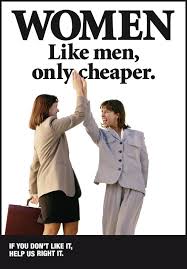They're lying again about the gender pay gap you know
Oh dear, oh dearie me. We find ourselves with a politician trying to feed us all porkies again. This time it's Gloria De Piero announcing loudly that the gender pay gap is near 20% (along with the usual this is disgusting, must stop, Labour will do something about it and so on). She's making the same claim that Harriet Harman did a few years ago: and she seems to have forgotten that the UK Statistics Authority said that Mrs. Dromey was in fact a very naughty politician indeed for making the claim in the manner she did. And as Del Piero is making the same claim in the same manner that also makes Ms. Del Piero a very naughty politician indeed. And we tend to think that it's worth calling out politicians when they attempt to mislead us all by being so naughty.
You can see the actual claims being made all laid out in charts here at the Mail. Full time male employees make more than full time female employees. Part time female employees make more than part time male employees. There are many more female part timers than male: and the average part time wage for either gender is lower than the full time wage for either or both.
And what Del Piero has done to get to her 20% or so figure (the actual numbers coming from the correct source, ASHE) is to include the part time and full time female numbers into one, the part time and full time male numbers into one, and then compare the two. This is not acceptable. As Sir Michael Scholar pointed out to Harriet Harman when she did the same those years ago:
GOVERNMENT EQUALITIES OFFICE PRESS RELEASE: 27 APRIL 2009 I am writing to you about the Government Equalities Office (GEO) Press Release on the Equality Bill, issued on 27 April, which states that women are paid on average 23 per cent less per hour than men. GEO’s headline estimate of the difference between the earnings of women compared with men (generally referred to as the gender pay gap) is some 10 percentage points higher than the 12.8 per cent figure quoted by the Office for National Statistics (ONS). Yet both estimates are derived from the same source, the 2008 Annual Survey of Hours and Earnings (ASHE). Such a difference in headline estimates is likely to confuse the general public. The Statistics Authority is concerned that this may undermine public trust in official statistics. I understand that there has been a dialogue between ONS and GEO on the presentation of women’s earnings figures in the context of Equality issues and that the National Statistician has agreed to look at the way the gender pay gap is presented in ONS statistical bulletins. Work on this is planned for later this year and will be used to inform the content of ONS’s statistical bulletin on the results of the 2009 ASHE, due in November 2009. In the meantime, I enclose a copy of a note that the Statistics Authority will shortly publish on its website. This clarifies why figures as different as 12.8 per cent and 23 per cent have been used and explores different options for presenting the gender pay gap in an impartial and objective way. The note explains that the figure of 23 per cent quoted in the GEO press release relates to the median hourly earnings of all employees (full-time and part-time combined) whereas ONS's figure of 12.8 per cent is based on the difference in the median hourly earnings of full-time employees only. Neither measure is entirely satisfactory as an impartial and objective headline estimate. The former rolls together the quite different levels of hourly earnings for part-time and full-time employees; while the latter excludes the earnings of around one quarter of all employees. These considerations suggest the need for a more extensive set of measures to present the differences between the earnings of men and women. Indeed, it is the Statistics Authority’s view that use of the 23% on its own, without qualification, risks giving a misleading quantification of the gender pay gap. I trust that you will find this note of value pending the further work that ONS is planning on this issue later this year.
That does indeed make Ms. Del Piero a very naught politician indeed and as she does the rounds of the talk and news shows to promote this old Labour mistake perhaps someone would like to pick her up on it?
As to the reality of the gender pay gap it's made up of two things. The first is that there really was, historically, direct discrimination against women in education and career opportunities. That is something almost entirely solved for today's younger generation and we see the effects still only in the older age cohorts, in the inequality of wages of people in their 40s and older. There is no such inequality among the young.
The second is that women tend to take career breaks in order to have and to raise their children in a manner that the fathers of those same children do not. We might rail against that sexist notion that this should be so but it's hardly an unusual gender division of labour in a viviparous, mammalian, species.
The part of the gender pay gap that comes from direct discrimination has already been dealt with, the part that comes from how people decide to live their lives and raise their children, well, that will be with us for as long as that's how people decide that they want to live their lives and raise their children.
And adding together part and full time wages to describe the gender pay gap is a naughty thing to do. As the Statistics Authority has already told one Labour politician when they did it.

